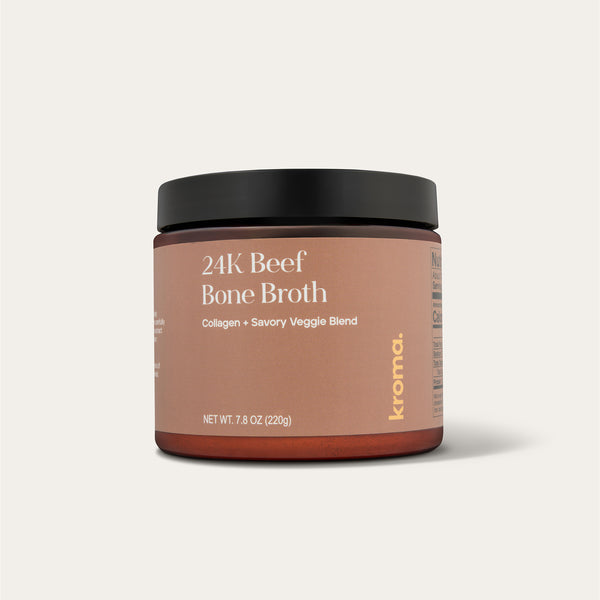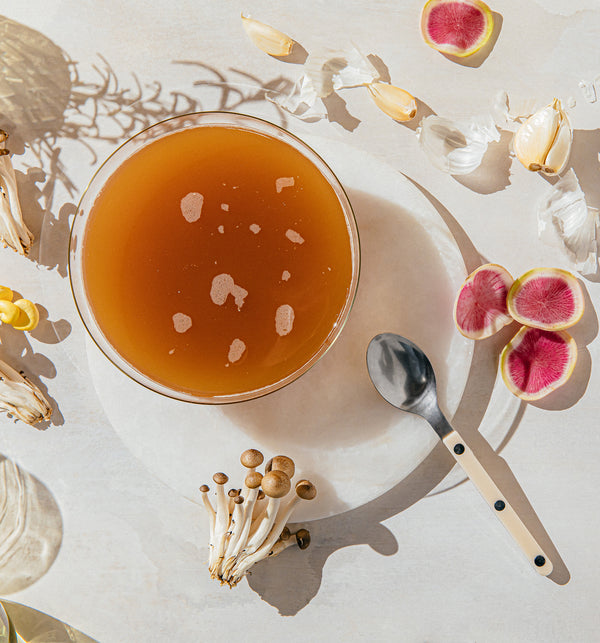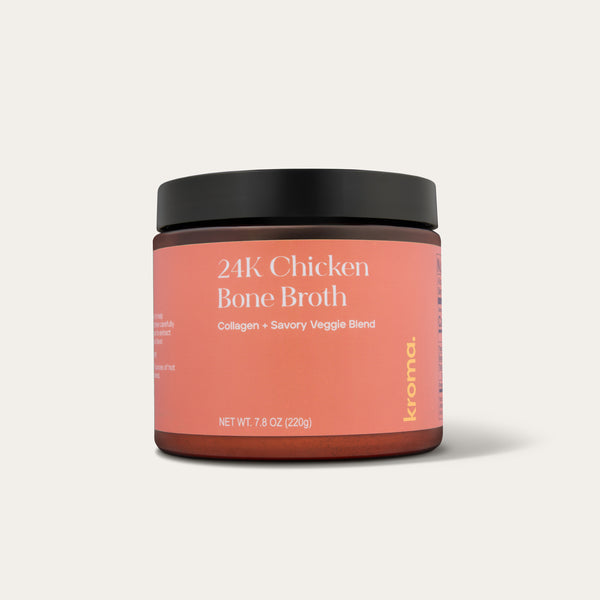Nowadays, it seems you can't look at social media, listen to a fitness podcast, or catch up with your latest health magazine without hearing about someone enjoying the benefits of bone broth.
You may have even heard of people switching out their morning coffee or tea with bone broth, but what is behind all of the hype? Have you wondered if you should start incorporating bone broth into your own life?
Sure, we all grew up eating chicken noodle soup when we had a cold, but there has to be more to this broth to make it such a superstar in the health and wellness space. Is it easy to make, or are there prepackaged options? What are the specific nutrients found in bone broth, and why are those nutrients important? Most importantly, how does bone broth benefit my overall health?
There is a lot to learn about this powerful liquid, and like you, we wanted to dig a little deeper into understanding the hows and whys of the benefits of bone broth, and how to add it to our daily lives.
We have explored what goes into making bone broth, the nutrients within it, how to add it to our daily routine, and if a vegan broth can have the same benefits. Bone broth may have started as a fad, but it’s definitely here to stay. Here are five little-known benefits to get you in the bone broth loop:
What Is Bone Broth?

Bone broth is essentially stock made with animal bones and anything inedible such as beaks, knuckles, and fins. By boiling these items in water for an extended period of time, you are pulling out all of the nutrients, which otherwise couldn’t be consumed.
Bone broth is packed full of vitamins, minerals, and other nutrients. These nutrients feed your body in an easily digestible way, providing many benefits, from bone and joint health to digestion.
Let’s explore more on the different types of bones needed to make a well-rounded, nutrient-dense broth.
Bone
Bones are full of nutrients, but you can’t just broil them up for dinner. Making bone broth allows you to pull out the calcium and phosphorus found in the bones, which can help maintain the health and strength of our bones in return.
Marrow
Marrow is found inside the bones themselves. Usually found in the spine, hips, and thigh bones, this spongy tissue is full of collagen, omega-3s, omega-6s, and other nutrients that help support full-body health.
Connective Tissue
Connective tissue is what keeps our form. Without the connective tissue, bones could not stay in their place. Think ligaments, tendons, cartilage, and fat tissues. This tissue provides glucosamine and chondroitin, which, when drinking bone broth, gets absorbed into our bodies and supports our connective tissue.
How Do I Make Bone Broth?

Although bone is in its name, bone broth is made with more than just bones. Including bones, add in knuckles, feet, fins, joints, or basically anything on the animal that would otherwise go to waste.
The best place to find what you need is by going to your local butcher. They will have plenty of options for you. The more diverse the animal products you use, the more variety of nutrients you will have.
Once you have your selection of bones, take the time to roast them. You will not regret this step. This will add a depth of flavor to your stock that you would not normally attain from simmering alone.
After roasting, add these to a stockpot or slow cooker with water. The one surprising ingredient is vinegar. You will need to add an acid like apple cider vinegar to your stock, as it helps to break down the connective tissue and pull out the protein, collagen, and other nutrients.
When you have your ingredients in the pot, bring the water up to a simmer. You’ll want to let this simmer for 8 to 24 hours. You can also add vegetables like onion, carrots, and celery to amp up the flavor and add even more nutrients.
Herbs are also a great way to add more flavor. It is recommended to add your produce in at the last hour or so, as to not risk any bitter or overly sweet taste from the vegetables.
Once your stock has finished, strain out all of the solids, and you will be left with a luscious, silky-textured broth.
We know not everyone has hours to make their own bone broth. At Kroma Wellness, we are simplifying how people integrate functional superfood nutrition into their daily lives. With our bone broth, you can skip the trips to the butcher and save time, all while still reaping all of the nutritional benefits bone broth has to offer.
Does It Matter Which Kind of Bones I Use?
More important than the specific types of bones is the variety of bones, as this increases the variety of nutrients and flavor.
You want to be sure to include bones that have a lot of connective tissue, like feet, knuckles, and joints, as these have the highest concentration of collagen.
Larger beef bones are full of nutrients, too. Meatier bones like oxtail and short ribs add more flavor to your broth.
Making sure you have a variety of bone types will give you a more robust soup flavor and more health benefits.
Since bone broth is a healing broth, you want to make sure you are putting in the best quality ingredients. Perhaps you have a local farm or a good quality butcher to get your bones. Here, you will be able to explain what you are looking for and let them guide you in the right direction.
If you do not have a local butcher, try to look for organic options at your local grocer. When visiting your butcher or the grocery store, make sure to ask them to cut your bones into appropriate sizes to fit in your stockpot or slow cooker.
Can Bone Broth Be Vegan?

You can get many of the same benefits of bone broth in a vegan broth. By using an array of vegetables, mushrooms, seaweed, ginger, fresh herbs, and spices, you will gain all of the nutrients that you would find in a traditional bone broth.
A great way to make vegan bone broth is by saving your vegetable scraps in the freezer. When you are ready to make vegan broth, you can use these scraps and your fresh vegetables to make a delicious vegan broth.
The one nutrient you will not get is collagen. Instead of directly ingesting collagen, vegans need to consume nutrients that help the body make its own — i.e., ingredients that help support the production of collagen.
Broccoli, Brussels sprouts, leafy greens, bell peppers, and mushrooms will give you nutrients that help in the collagen-making process, like vitamin C, zinc, and copper.
Why Is Bone Broth Good for You?

The nutrients found in bones and vegetables make this broth especially good for you. In addition, the broth is easy to digest, making it easier for your body to absorb the nutrients. Let's take a closer look at these nutrients to understand why they are so important.
Packed with Vitamins
Bone broth is filled with vitamins like vitamin A, vitamin K2, and vitamin B12. Vitamin A is good for eye, immune, and reproductive health. It also helps organs function at their best. Vitamin K2 supports bone and vascular health, and vitamin B12 maintains the health of blood and nerve cells.
Rich in Minerals
Bones themselves contain many minerals. Slow cooking these bones into a broth, along with the vegetables, pulls out those minerals.
Some of the minerals found in bone broth are calcium, phosphorus, sodium, magnesium, and potassium.
Since our bones are 65% hydroxyapatite, an insoluble salt of calcium and phosphorus, it is important that we consume these nutrients in our diets.
Includes Iodine
Including fish bones and fins in your bone broth will add iodine. Iodine is stored in the thyroid gland because it’s crucial to the body’s production of thyroid hormones, which play a role in virtually every system in your body from metabolism to nervous system function.
If you are keeping your broth vegan, seaweed is the best source of iodine. Seaweed will not give your broth a fishy flavor, but simply increase the depth of umami flavor.
Contains Glucosamine and Chondroitin
Glucosamine and chondroitin are structural components of cartilage. While your stock is simmering, you want to make sure these nutrients are pulled out and stay in the broth. This is where the vinegar really plays its part — the vinegar will help break down the cartilage, allowing the nutrients to come out into the broth.
Includes Collagen
Found in the marrow, collagen is vastly important for healthy skin elasticity, and joint and bone health. Letting your broth simmer for a long time allows the collagen to come out of the bone marrow and into the broth. Drinking the bone broth will let the collagen absorb more easily into your body.
If you are drinking vegan broth, the vitamin C, copper, and zinc found in broccoli, leafy greens, bell peppers, and mushrooms will help your body to make its own collagen.
5 Little-Known Benefits of Bone Broth

Now that we know the nutrients available in bone broth, what do they help us with?
We are all about a full-body approach to wellness, and bone broth aligns with this perfectly. The benefits of bone broth are extensive, however there are five little-known benefits that will have you wanting to sip on some bone broth whenever you can.
Promotes Healthy Thyroid Function
Remember the iodine we learned about? Iodine helps with thyroid function. The thyroid is a small gland at the front of your neck, and it creates hormones that help with the most vital functions in the body. Its biggest job is to create and release hormones for metabolism. Once the food that you eat is metabolized, it creates energy for all of the other systems in your body.
Builds and Strengthens Bones
Most people think of bones as hard, solid building blocks for the structure of our body. While this is true that bones are hard and keep our structure, they are not “solid.” Bones are made out of a honeycomb structure, with some completely hollow in the middle, like the femur. This structure allows our bones to be lighter so it’s easier for us to move and carry our own weight.
The collagen, calcium, phosphorus, and vitamins in bone broth help build and strengthen your bones. Bones are always changing. Every day, your bones are getting rid of old cells and making new cells to stay as strong and healthy as possible.
Helps Digestion
The collagen, along with amino acids, found in bone broth are very helpful in healing and maintaining the health of your gut. By supporting the health of the intestinal walls, your gut is better able to absorb all the nutrients not only in the bone broth, but all of the food you eat.
Improves Joint Health
Glucosamine and chondroitin are essential for healthy joints. Like many of the other nutrients in bone broth, where the nutrient comes from is often where it will help in the human body, and this is also true for glucosamine and chondroitin.
Supports Healthy Weight
We almost come full circle here. When your body metabolizes food properly, has a strong digestion system to absorb nutrients, and has strong bones and joints to move without pain, a healthy weight will be an added bonus.
Since bone broth is made with whole food ingredients, you are getting real nutrients and you feel full, even when it has very few calories.
How Often Should I Drink Bone Broth?
During the Kroma Wellness 5-Day Reset, we recommend drinking bone broth for lunch and dinner. When you are not doing the Kroma 5-Day Reset, you should drink bone broth once or twice a day for optimum health benefits.
Keep it interesting! There are many ways to enjoy bone broth. You can use it to make a soup full of veggies, make a bowl of gluten-free ramen, or simply drink it. If you choose to drink it, you can add lemon and ginger to enhance the taste.
The Bottom Line

With all the health benefits of bone broth, we wouldn’t be surprised if you’ve already Googled what time your local butcher shop is closing today.
Bone broth nourishes your body from the inside out, making it a valuable addition to your healthy lifestyle.
At Kroma Wellness, we are all about empowering you to live a healthy lifestyle. We also know everyone doesn’t always know where to start. With our bone broths, you can know you are getting the best quality bone broth, and you can start to feel what well-being is really like as you slowly make changes to more nutritious foods like this one.
Here is to your wellness journey. We raise our cup of bone broth to you!











